Items
-
 Burrill Street, 142-148 View of 142-148 Burrill Street from across the street. There is a residence to the left and a used car dealership to the right.
Burrill Street, 142-148 View of 142-148 Burrill Street from across the street. There is a residence to the left and a used car dealership to the right. -
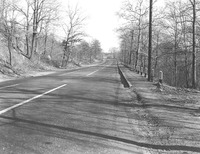 Paradise Road, 1941 View along a paved Paradise Road in 1941. This location is approximately 331 Paradise Road, home of the Whole Foods Market (2008) and former site of the Foodmaster grocery store.
Paradise Road, 1941 View along a paved Paradise Road in 1941. This location is approximately 331 Paradise Road, home of the Whole Foods Market (2008) and former site of the Foodmaster grocery store. -
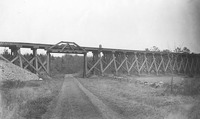 Paradise Road railroad trestle View of the wooden railroad trestle from Paradise Road.
Paradise Road railroad trestle View of the wooden railroad trestle from Paradise Road. -
 Henry Leger and Ed Wiley split mackerel Partners Henry Leger and Ed Wiley split mackerel. Although one of the men had to walk with a cane, the two could still do a day's work. Transport is close at hand to take the cut fish up the beach to be salted."--from Images of America : Swampscott, Turino and Mathias, 1996
Henry Leger and Ed Wiley split mackerel Partners Henry Leger and Ed Wiley split mackerel. Although one of the men had to walk with a cane, the two could still do a day's work. Transport is close at hand to take the cut fish up the beach to be salted."--from Images of America : Swampscott, Turino and Mathias, 1996 -
 Henry and Jack Cullen and their Portuguese water dog Henry and Jack Cullen pose with an unidentified man and their Portuguese water dog near the Swampscott fishing shanties
Henry and Jack Cullen and their Portuguese water dog Henry and Jack Cullen pose with an unidentified man and their Portuguese water dog near the Swampscott fishing shanties -
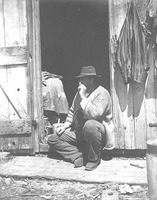 Rodney A. Douglass Informal portrait of Rodney A Douglass
Rodney A. Douglass Informal portrait of Rodney A Douglass -
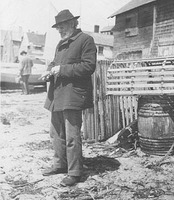 Alonzo Carey Alonzo Carey stands on Fishermen's (?) Beach in front of a lobster trap
Alonzo Carey Alonzo Carey stands on Fishermen's (?) Beach in front of a lobster trap -
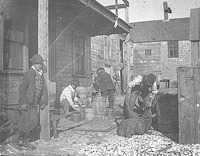 John Slattery John Slattery works outside of a Swampscott fishhouse, while two men attend to tasks in the background and a boy looks on
John Slattery John Slattery works outside of a Swampscott fishhouse, while two men attend to tasks in the background and a boy looks on -
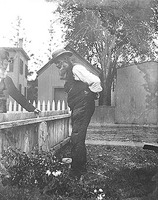 John Chapman and Miles Blanchard Captain Miles Blanchard and John Chapman stand talking on either side of a fence
John Chapman and Miles Blanchard Captain Miles Blanchard and John Chapman stand talking on either side of a fence -
 Portrait of Dr. Lawrence Portrait of Dr Lawrence
Portrait of Dr. Lawrence Portrait of Dr Lawrence -
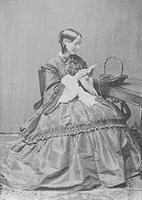 Portrait of Dr. Lawrence's wife Formal portrait of the wife of Dr Lawrence seated at a table doing needlepoint
Portrait of Dr. Lawrence's wife Formal portrait of the wife of Dr Lawrence seated at a table doing needlepoint -
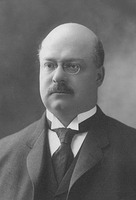 Portrait of John M. Grosvenor, Jr. Portrait of John M. Grosvenor, Jr. John Milton Grosvernor, Jr. was born in Woburn in 1864. He attended M.I.T. and became a chemist. Married Lilian Pitman Munson of Swampscott in 1894. Grosvenor was a junior member of the firm J.M. Grosvenor & Co., importers and manufacturing chemists, which was founded in 1868. He was the president and treasurer of the Annals Publishing Co., publishers of the Annals of Gynecology and Pediatry former chairman of the Republican Town Committee, park commissioner, a member of the Massachusetts House of Representatives (1904-05) and a member of the Massachusetts State Senate in 1906. Grosvenor was also an Essex County Commissioner beginning in 1907, a trustee of the Essex County Agricultural School.--from "Who's who in New England," edited by Albert Nelson Marquis, 1916.
Portrait of John M. Grosvenor, Jr. Portrait of John M. Grosvenor, Jr. John Milton Grosvernor, Jr. was born in Woburn in 1864. He attended M.I.T. and became a chemist. Married Lilian Pitman Munson of Swampscott in 1894. Grosvenor was a junior member of the firm J.M. Grosvenor & Co., importers and manufacturing chemists, which was founded in 1868. He was the president and treasurer of the Annals Publishing Co., publishers of the Annals of Gynecology and Pediatry former chairman of the Republican Town Committee, park commissioner, a member of the Massachusetts House of Representatives (1904-05) and a member of the Massachusetts State Senate in 1906. Grosvenor was also an Essex County Commissioner beginning in 1907, a trustee of the Essex County Agricultural School.--from "Who's who in New England," edited by Albert Nelson Marquis, 1916. -
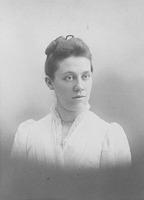 Portrait of Sadie (Pierce) Hougton, Beach Street Formal portrait of Sadie (Pierce) Houghton of Beach Street, Swampscott, Massachusetts.
Portrait of Sadie (Pierce) Hougton, Beach Street Formal portrait of Sadie (Pierce) Houghton of Beach Street, Swampscott, Massachusetts. -
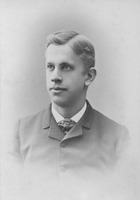 Portrait of Edward Albree Portrait of Edward Albree, 1885.
Portrait of Edward Albree Portrait of Edward Albree, 1885. -
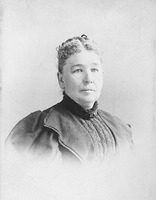 Portrait of Mrs. William Gaston Formal portrait of Mrs. Gaston, wife of the governor. Louisa Beecher was the daughter of Laban S. and Frances A. (Lines) Beecher. Her father was a lumber merchant in Roxbury, Mass. She married William Gaston on May 27, 1852 in Roxbury, MA. and had three children: Sarah Howard, Theodore Beecher, and William Alexander Gaston. Her husband, William Gaston, served as mayor of Roxbury (1861-1862) and of Boston (1871-1872). He was elected as governor of Massachusetts in 1875. After losing his bid for re-election, Gaston returned to his successful law practice in Roxbury. Gaston had also served as a Representative in the State Legislature (1853-1854), as Roxbury's City Solicitor (1856-60).--from the Official Massachusetts Governor biography (www.mass.gov) and Biographical history of Massachusetts : biographies and autobiographies of the leading men of the state, Samuel Atkins Eliot, 1909.
Portrait of Mrs. William Gaston Formal portrait of Mrs. Gaston, wife of the governor. Louisa Beecher was the daughter of Laban S. and Frances A. (Lines) Beecher. Her father was a lumber merchant in Roxbury, Mass. She married William Gaston on May 27, 1852 in Roxbury, MA. and had three children: Sarah Howard, Theodore Beecher, and William Alexander Gaston. Her husband, William Gaston, served as mayor of Roxbury (1861-1862) and of Boston (1871-1872). He was elected as governor of Massachusetts in 1875. After losing his bid for re-election, Gaston returned to his successful law practice in Roxbury. Gaston had also served as a Representative in the State Legislature (1853-1854), as Roxbury's City Solicitor (1856-60).--from the Official Massachusetts Governor biography (www.mass.gov) and Biographical history of Massachusetts : biographies and autobiographies of the leading men of the state, Samuel Atkins Eliot, 1909. -
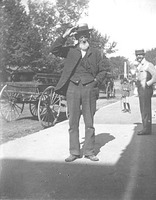 Gratin Martin and Jim Taylor Informal portrait of Gratin Martin and Jim Taylor standing on a sidewalk
Gratin Martin and Jim Taylor Informal portrait of Gratin Martin and Jim Taylor standing on a sidewalk -
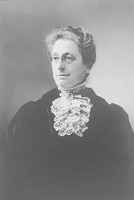 Portrait of Mrs. Carl Wilhelm Ernst Format portrait of Abbie Snow (Hart) Ernst, only daughter of Thomas N. Hart, Mayor of Boston, from 1889 to 1890 and from 1900 to 1902
Portrait of Mrs. Carl Wilhelm Ernst Format portrait of Abbie Snow (Hart) Ernst, only daughter of Thomas N. Hart, Mayor of Boston, from 1889 to 1890 and from 1900 to 1902 -
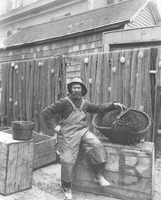 Portrait of William B. Phillips Portrait of fisherman William B. Phillips posing in his fishing gear in front of nets strung along a fence
Portrait of William B. Phillips Portrait of fisherman William B. Phillips posing in his fishing gear in front of nets strung along a fence -
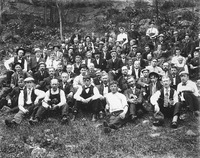 Outing of Red Men Members of American Legion "Red Men" pose for a photo during an outing in June 1907
Outing of Red Men Members of American Legion "Red Men" pose for a photo during an outing in June 1907 -
 Portrait of Mr. and Mrs. Fred Sullivan Portrait of Mr. and Mrs. Fred Sullivan standing in their living room
Portrait of Mr. and Mrs. Fred Sullivan Portrait of Mr. and Mrs. Fred Sullivan standing in their living room -
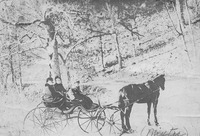 Galloupe's Point ladies driven by Johnnie Hutt Two women from Galloupe's Point sit in a horse-drawn carriage driven by eight-year-old Johnnie Hutt--from Images of America : Swampscott, Turino and Mathias, 1996
Galloupe's Point ladies driven by Johnnie Hutt Two women from Galloupe's Point sit in a horse-drawn carriage driven by eight-year-old Johnnie Hutt--from Images of America : Swampscott, Turino and Mathias, 1996 -
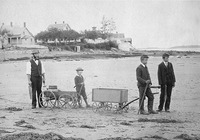 William Murray, Frederic Lewis, Edward Albree, and Weston K. Lewis William Murray, Frederic H. Lewis, Edward Albree, and Weston K. Lewis walk along the beach pulling two small wagons. Murray carries a hammer in one hand and a saw in the other. Edward Albree and Weston K. Lewis worked at the Lincoln House stables, while Murray was a coachman.--from Then & now : Swampscott, Sue Ellen Woodcock, c2002.
William Murray, Frederic Lewis, Edward Albree, and Weston K. Lewis William Murray, Frederic H. Lewis, Edward Albree, and Weston K. Lewis walk along the beach pulling two small wagons. Murray carries a hammer in one hand and a saw in the other. Edward Albree and Weston K. Lewis worked at the Lincoln House stables, while Murray was a coachman.--from Then & now : Swampscott, Sue Ellen Woodcock, c2002. -
 Mrs. D. Holman Willett Mrs. D. Holman Willett and companions in front of 193 Humphrey Street. Four women sit in a horse drawn carriage, one stands on the porch and one stands with the horse.
Mrs. D. Holman Willett Mrs. D. Holman Willett and companions in front of 193 Humphrey Street. Four women sit in a horse drawn carriage, one stands on the porch and one stands with the horse. -
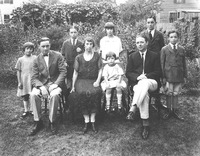 Portrait of the Stone family Portrait of Dick Stone and his family posing in their yard
Portrait of the Stone family Portrait of Dick Stone and his family posing in their yard -
 Michael J. Ryan Michael J. Ryan sits in a horsedrawn carriage outside of a Swampscott residence
Michael J. Ryan Michael J. Ryan sits in a horsedrawn carriage outside of a Swampscott residence -
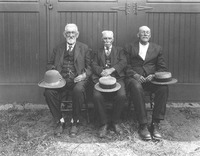 Portrait of Perley Kendrick, Abe Stone, and George Harris Portrait of Perley Kendrick, Abe Stone, and George Harris, seated with hats on their laps, in 1926
Portrait of Perley Kendrick, Abe Stone, and George Harris Portrait of Perley Kendrick, Abe Stone, and George Harris, seated with hats on their laps, in 1926 -
 Phil Crowley salting fish Fisherman "Phil Crowley salts down the split fish."--from Images of America : Swampscott, Turino and Mathias, 1996
Phil Crowley salting fish Fisherman "Phil Crowley salts down the split fish."--from Images of America : Swampscott, Turino and Mathias, 1996 -
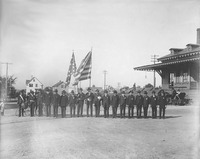 Grand Army of the Republic Members of the Grand Army of the Repbulic (GAR) pose in uniform and with flags in front of the Swampscott train station. Pictured are: Elmer Thomas, drummer, William Gardner, Eldrige Blaney, Joe Glass, Eben Martin, Orlando Pinkham, William Earp, Ed Marsh, John I. Adams, William Fay, George Connor, unidentified, James Alger, Peleg Gardner, Charles Rodrick, George Newhall, unidentified, Orlando Millett.
Grand Army of the Republic Members of the Grand Army of the Repbulic (GAR) pose in uniform and with flags in front of the Swampscott train station. Pictured are: Elmer Thomas, drummer, William Gardner, Eldrige Blaney, Joe Glass, Eben Martin, Orlando Pinkham, William Earp, Ed Marsh, John I. Adams, William Fay, George Connor, unidentified, James Alger, Peleg Gardner, Charles Rodrick, George Newhall, unidentified, Orlando Millett. -
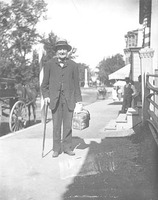 James Wheeler Informal portrait of James Wheeler posing on a sidewalk.
James Wheeler Informal portrait of James Wheeler posing on a sidewalk. -
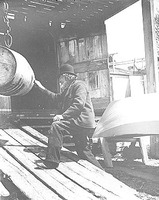 John Smith in a fishhouse Fisherman John Smith inspects a barrel/float inside a fishhouse.
John Smith in a fishhouse Fisherman John Smith inspects a barrel/float inside a fishhouse. -
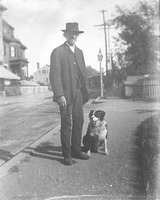 Portrait of Frank Nesbett Informal portrait of Frank Nesbett standing on a sidewalk with a dog.
Portrait of Frank Nesbett Informal portrait of Frank Nesbett standing on a sidewalk with a dog. -
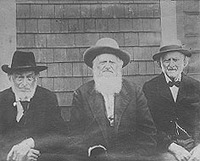 Portrait of Charles Haskell, Ed Marsh, and Frank Nesbett Portrait of Charles Haskell a cobbler, Edward Marsh, a fisherman, and Frank Nesbett, a janitor.
Portrait of Charles Haskell, Ed Marsh, and Frank Nesbett Portrait of Charles Haskell a cobbler, Edward Marsh, a fisherman, and Frank Nesbett, a janitor. -
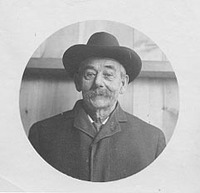 Portrait of Dick Gilley Portrait of Dick Gilley in a circular frame.
Portrait of Dick Gilley Portrait of Dick Gilley in a circular frame. -
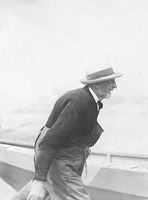 F.W. Brackett F.W. Brackett, dressed in foul weather gear, peering over a wall.
F.W. Brackett F.W. Brackett, dressed in foul weather gear, peering over a wall. -
 Eben Martin Fisherman Eben Martin leans on his dory at the water's edge.
Eben Martin Fisherman Eben Martin leans on his dory at the water's edge. -
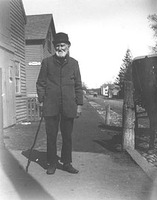 Portrait of Solomon Abbott Informal portrait of fisherman Solomon Abbott
Portrait of Solomon Abbott Informal portrait of fisherman Solomon Abbott -
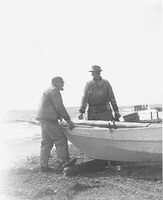 Charles Abbott and "Legs" Jones Fishermen, Charles Abbott and "Legs" Jones, stand on a beach leaning on a fishing dory.
Charles Abbott and "Legs" Jones Fishermen, Charles Abbott and "Legs" Jones, stand on a beach leaning on a fishing dory. -
 Blocksidge Field View of the Blocksidge playing field in 1936. Beyond the field, on a hill overlooking it, is the former Cook Estate on Ocean View Road.
Blocksidge Field View of the Blocksidge playing field in 1936. Beyond the field, on a hill overlooking it, is the former Cook Estate on Ocean View Road. -
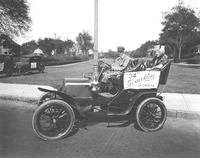 '04' Franklin granddad "The Franklin motor car was invented by the engineer John Wilkinson and manufactured by the industrialist H. H. Franklin and marketed under his name. The Franklin was one of the most innovative motor cars of its time, featuring an air-cooled engine, scientific light weight and flexible construction at a time when other luxury car manufacturers were making ponderous machines. Throughout its history Franklin was a luxury car and it was in this part of the automotive market that it competed with the other notable makes of the day. As such it fell victim to the Great Depression along with many of these same fine luxury car manufacturers. These remarkable motor cars engendered such a loyal and faithful following that interest in these automobiles never died out. Many individuals continued to operate Franklins as their every day automobiles or preserved them right up to the emergence of the antique and classic hobby, decades after production ceased in 1934. The H. H. Franklin Manufacturing Company was a very large employer in Syracuse, New York area, its home base...--Onondaga Historical Association website, viewed 3/12/2008.
'04' Franklin granddad "The Franklin motor car was invented by the engineer John Wilkinson and manufactured by the industrialist H. H. Franklin and marketed under his name. The Franklin was one of the most innovative motor cars of its time, featuring an air-cooled engine, scientific light weight and flexible construction at a time when other luxury car manufacturers were making ponderous machines. Throughout its history Franklin was a luxury car and it was in this part of the automotive market that it competed with the other notable makes of the day. As such it fell victim to the Great Depression along with many of these same fine luxury car manufacturers. These remarkable motor cars engendered such a loyal and faithful following that interest in these automobiles never died out. Many individuals continued to operate Franklins as their every day automobiles or preserved them right up to the emergence of the antique and classic hobby, decades after production ceased in 1934. The H. H. Franklin Manufacturing Company was a very large employer in Syracuse, New York area, its home base...--Onondaga Historical Association website, viewed 3/12/2008. -
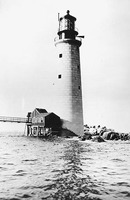 Graves Light, Boston Harbor; close-up view Graves Light is one of Massachusetts' youngest lighthouses. An iron bell buoy was placed near the ledges called the Graves in 1854. It was later replaced by a whistling buoy beyond the northeast end of the ledges. A new major shipping channel into Boston Harbor, the Broad Sound Channel, opened in the early 1900s, necessitating a lighthouse at the Graves. In 1902, Congress appropriated $75,000 for a lighthouse and fog signal, and Governor Crane of Massachusetts signed a deed conveying 435,400 square feet at the ledges to the federal government. The project ultimately cost $188,000, meaning a second appropriation of $113,000 was required in April 1904. Construction took place from 1903 to 1905, and Royal Luther of Malden, Massachusetts, was in charge. The style of Graves Light is very similar to Maine's Ram Island Ledge Light, built at about the same time. The granite for the tower was cut at Rockport on Cape Ann. Rock on the ledges was blasted, and the foundation was laid just four feet above the low tide mark. The first 42 feet were completed in the summer of 1903. While the granite was being put in place, the ironwork was being manufactured in Boston and a huge first-order Fresnel lens was being created in Paris. The summer of 1904 saw the lighthouse reach a height of 88 feet. Construction was completed during the following year. A granite oil house was built 90 feet south of the tower, reachable by a footbridge. On the night of September 1, 1905, Graves Light's first keeper, Elliot C. Hadley, lighted the most powerful light in Massachusetts history for the first time. The gigantic lens floated on 400 pounds of mercury. Storms and vandalism have done their share of damage. The old walkway has been destroyed by storms, and vandals have caused thousands of dollars in damage. The fog signal house was swept away by the "Perfect Storm" of October 1991. The badly damaged landing platform was repaired in 1993. The original oil house still stands. The submarine cable from the town of Hull that powered Grave
Graves Light, Boston Harbor; close-up view Graves Light is one of Massachusetts' youngest lighthouses. An iron bell buoy was placed near the ledges called the Graves in 1854. It was later replaced by a whistling buoy beyond the northeast end of the ledges. A new major shipping channel into Boston Harbor, the Broad Sound Channel, opened in the early 1900s, necessitating a lighthouse at the Graves. In 1902, Congress appropriated $75,000 for a lighthouse and fog signal, and Governor Crane of Massachusetts signed a deed conveying 435,400 square feet at the ledges to the federal government. The project ultimately cost $188,000, meaning a second appropriation of $113,000 was required in April 1904. Construction took place from 1903 to 1905, and Royal Luther of Malden, Massachusetts, was in charge. The style of Graves Light is very similar to Maine's Ram Island Ledge Light, built at about the same time. The granite for the tower was cut at Rockport on Cape Ann. Rock on the ledges was blasted, and the foundation was laid just four feet above the low tide mark. The first 42 feet were completed in the summer of 1903. While the granite was being put in place, the ironwork was being manufactured in Boston and a huge first-order Fresnel lens was being created in Paris. The summer of 1904 saw the lighthouse reach a height of 88 feet. Construction was completed during the following year. A granite oil house was built 90 feet south of the tower, reachable by a footbridge. On the night of September 1, 1905, Graves Light's first keeper, Elliot C. Hadley, lighted the most powerful light in Massachusetts history for the first time. The gigantic lens floated on 400 pounds of mercury. Storms and vandalism have done their share of damage. The old walkway has been destroyed by storms, and vandals have caused thousands of dollars in damage. The fog signal house was swept away by the "Perfect Storm" of October 1991. The badly damaged landing platform was repaired in 1993. The original oil house still stands. The submarine cable from the town of Hull that powered Grave -
 Graves Light, Boston Harbor Graves Light is one of Massachusetts' youngest lighthouses. An iron bell buoy was placed near the ledges called the Graves in 1854. It was later replaced by a whistling buoy beyond the northeast end of the ledges. A new major shipping channel into Boston Harbor, the Broad Sound Channel, opened in the early 1900s, necessitating a lighthouse at the Graves. In 1902, Congress appropriated $75,000 for a lighthouse and fog signal, and Governor Crane of Massachusetts signed a deed conveying 435,400 square feet at the ledges to the federal government. The project ultimately cost $188,000, meaning a second appropriation of $113,000 was required in April 1904. Construction took place from 1903 to 1905, and Royal Luther of Malden, Massachusetts, was in charge. The style of Graves Light is very similar to Maine's Ram Island Ledge Light, built at about the same time. The granite for the tower was cut at Rockport on Cape Ann. Rock on the ledges was blasted, and the foundation was laid just four feet above the low tide mark. The first 42 feet were completed in the summer of 1903. While the granite was being put in place, the ironwork was being manufactured in Boston and a huge first-order Fresnel lens was being created in Paris. The summer of 1904 saw the lighthouse reach a height of 88 feet. Construction was completed during the following year. A granite oil house was built 90 feet south of the tower, reachable by a footbridge. On the night of September 1, 1905, Graves Light's first keeper, Elliot C. Hadley, lighted the most powerful light in Massachusetts history for the first time. The gigantic lens floated on 400 pounds of mercury. Storms and vandalism have done their share of damage. The old walkway has been destroyed by storms, and vandals have caused thousands of dollars in damage. The fog signal house was swept away by the "Perfect Storm" of October 1991. The badly damaged landing platform was repaired in 1993. The original oil house still stands. The submarine cable from the town of Hull that powered Grave
Graves Light, Boston Harbor Graves Light is one of Massachusetts' youngest lighthouses. An iron bell buoy was placed near the ledges called the Graves in 1854. It was later replaced by a whistling buoy beyond the northeast end of the ledges. A new major shipping channel into Boston Harbor, the Broad Sound Channel, opened in the early 1900s, necessitating a lighthouse at the Graves. In 1902, Congress appropriated $75,000 for a lighthouse and fog signal, and Governor Crane of Massachusetts signed a deed conveying 435,400 square feet at the ledges to the federal government. The project ultimately cost $188,000, meaning a second appropriation of $113,000 was required in April 1904. Construction took place from 1903 to 1905, and Royal Luther of Malden, Massachusetts, was in charge. The style of Graves Light is very similar to Maine's Ram Island Ledge Light, built at about the same time. The granite for the tower was cut at Rockport on Cape Ann. Rock on the ledges was blasted, and the foundation was laid just four feet above the low tide mark. The first 42 feet were completed in the summer of 1903. While the granite was being put in place, the ironwork was being manufactured in Boston and a huge first-order Fresnel lens was being created in Paris. The summer of 1904 saw the lighthouse reach a height of 88 feet. Construction was completed during the following year. A granite oil house was built 90 feet south of the tower, reachable by a footbridge. On the night of September 1, 1905, Graves Light's first keeper, Elliot C. Hadley, lighted the most powerful light in Massachusetts history for the first time. The gigantic lens floated on 400 pounds of mercury. Storms and vandalism have done their share of damage. The old walkway has been destroyed by storms, and vandals have caused thousands of dollars in damage. The fog signal house was swept away by the "Perfect Storm" of October 1991. The badly damaged landing platform was repaired in 1993. The original oil house still stands. The submarine cable from the town of Hull that powered Grave -
 Armistice Day Observance, 1931 A crowd observes Armistice Day (Veterans' Day) in Swampscott on November 11, 1931, commemorating the anniversary of the end of World War I in 1918. The town's memorial to World War I veterans is located at Monument Square. Monument Square is the park-like gateway to Swampscott and the entrance to the Olmsted Subdivision. Its center is the intersection of Humphrey Street, Monument Avenue, and Burrill Street and is marked by a tall obelisk on a green triangular traffic island. The 30-foot granite obelisk is the Civil War Monument dedicated in 1883 to honor the 14 from Swampscott who died in the Civil War.-- from Swampscott Reconnaissance Report, Massachusetts Department of Conservation and Recreation Essex National Heritage Commission, 2005.
Armistice Day Observance, 1931 A crowd observes Armistice Day (Veterans' Day) in Swampscott on November 11, 1931, commemorating the anniversary of the end of World War I in 1918. The town's memorial to World War I veterans is located at Monument Square. Monument Square is the park-like gateway to Swampscott and the entrance to the Olmsted Subdivision. Its center is the intersection of Humphrey Street, Monument Avenue, and Burrill Street and is marked by a tall obelisk on a green triangular traffic island. The 30-foot granite obelisk is the Civil War Monument dedicated in 1883 to honor the 14 from Swampscott who died in the Civil War.-- from Swampscott Reconnaissance Report, Massachusetts Department of Conservation and Recreation Essex National Heritage Commission, 2005. -
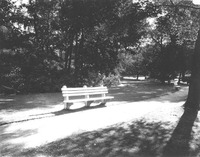 Howland Park Howland Park is the site of Swampscott's World War II memorial. The memorial is named in honor of Raymond L. Howland (1895-1918), who died during WW I.
Howland Park Howland Park is the site of Swampscott's World War II memorial. The memorial is named in honor of Raymond L. Howland (1895-1918), who died during WW I. -
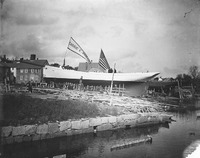 Carrie Phillips schooner Image showing the schooner Carrie E. Phillips under construction at the Arthur Story's Shipyard in Essex, MA. Piles of lumber lie in front of the ship and several men are visible on or near the vessel.
Carrie Phillips schooner Image showing the schooner Carrie E. Phillips under construction at the Arthur Story's Shipyard in Essex, MA. Piles of lumber lie in front of the ship and several men are visible on or near the vessel. -
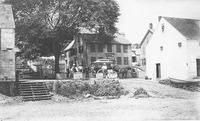 Omnibus and town pump on Humphrey Street Photograph shows a horse drawn omnibus and the town water pump. Several men are in the photo, which also shows the rear of some fish houses and a rowboat at the right.
Omnibus and town pump on Humphrey Street Photograph shows a horse drawn omnibus and the town water pump. Several men are in the photo, which also shows the rear of some fish houses and a rowboat at the right. -
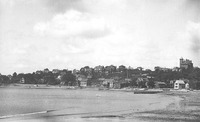 Blaney Beach Photo of Blaney Beach in Swampscott taken around 1913.
Blaney Beach Photo of Blaney Beach in Swampscott taken around 1913. -
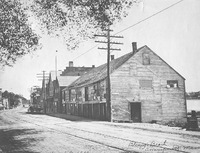 Fish houses on Humphrey Street, 1896 Photograph of fish houses located on Humphrey Street in Swampscott in 1897. Photo is taken at close range and written across the bottom is "Blaney's Beach Swampscott, Mass."
Fish houses on Humphrey Street, 1896 Photograph of fish houses located on Humphrey Street in Swampscott in 1897. Photo is taken at close range and written across the bottom is "Blaney's Beach Swampscott, Mass." -
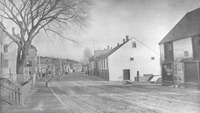 Fish houses on Humphrey Street, 1890 Photograph of fish houses located on Humphrey Street in Swampscott in 1890
Fish houses on Humphrey Street, 1890 Photograph of fish houses located on Humphrey Street in Swampscott in 1890 -
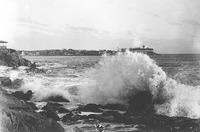 Distant view of Lincoln House Point Photograph of Lincoln House Point showing the Lincoln House in the background and breaking surf in the foreground
Distant view of Lincoln House Point Photograph of Lincoln House Point showing the Lincoln House in the background and breaking surf in the foreground -
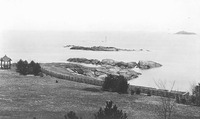 Dread Ledge Photograph of Dread Ledge in Swampscott taken from Galloupes's Point in 1885. There appears to be a gazebo at the far left.
Dread Ledge Photograph of Dread Ledge in Swampscott taken from Galloupes's Point in 1885. There appears to be a gazebo at the far left. -
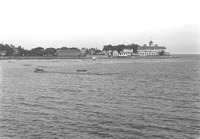 Lincoln House Point, 1903 Photograph of Lincoln House Point showing the Lincoln House across Swampscott Harbor and some small boats in Swampscott Harbor in the foreground.
Lincoln House Point, 1903 Photograph of Lincoln House Point showing the Lincoln House across Swampscott Harbor and some small boats in Swampscott Harbor in the foreground. -
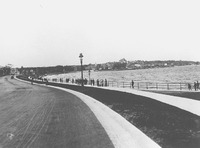 Lynn Shore Drive at King's Beach Pedestrians walk along the Lynn Shore Drive promenade. A lone carriage approaches along the unpaved street.
Lynn Shore Drive at King's Beach Pedestrians walk along the Lynn Shore Drive promenade. A lone carriage approaches along the unpaved street. -
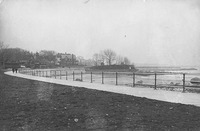 View from Lynn Shore Drive toward Galloupe's Point Pedestrians walk on a promenade along Lynn Shore Drive at low tide. Galloupe's Point is in the distance.
View from Lynn Shore Drive toward Galloupe's Point Pedestrians walk on a promenade along Lynn Shore Drive at low tide. Galloupe's Point is in the distance. -
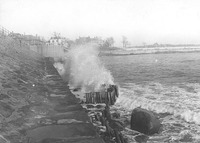 Surf breaking at Lynn Shore Drive Close-up view of surf crashing at the sea wall along Lynn Shore Drive.
Surf breaking at Lynn Shore Drive Close-up view of surf crashing at the sea wall along Lynn Shore Drive. -
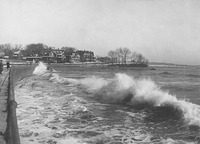 Surf breaking along Lynn Shore Drive View of surf crashing at the sea wall along Lynn Shore Drive. Pedestrians in overcoats walk along the sidewalk.
Surf breaking along Lynn Shore Drive View of surf crashing at the sea wall along Lynn Shore Drive. Pedestrians in overcoats walk along the sidewalk. -
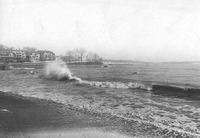 Surf at Lynn Shore Drive View from King's Beach at Lynn Shore Drive toward Galloupe's Point with surf rolling in
Surf at Lynn Shore Drive View from King's Beach at Lynn Shore Drive toward Galloupe's Point with surf rolling in -
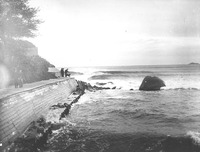 Surf at Lynn Shore Drive breakwater Photo shows a sea wall at the bottom of a hill with waves crashing. There are several men walking or standing on the wall, as well as one dog.
Surf at Lynn Shore Drive breakwater Photo shows a sea wall at the bottom of a hill with waves crashing. There are several men walking or standing on the wall, as well as one dog. -
 Surf crashing at Woodbury's Point;#2 Strong surf pounds the shore at Woodbury's Point
Surf crashing at Woodbury's Point;#2 Strong surf pounds the shore at Woodbury's Point -
 Surf crashing at Woodbury's Point Strong surf pounds the shore at Woodbury's Point
Surf crashing at Woodbury's Point Strong surf pounds the shore at Woodbury's Point -
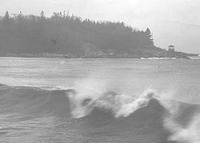 Galloupe's and Jeffrey's Points Surf crashes on the beach ahead of Galloupe's and Jeffrey's Points
Galloupe's and Jeffrey's Points Surf crashes on the beach ahead of Galloupe's and Jeffrey's Points -
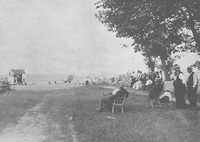 Gathering at King's Beach A group of men and women gather at King's Beach
Gathering at King's Beach A group of men and women gather at King's Beach -
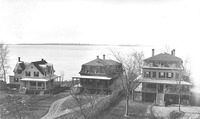 Ocean scene with homes Photograph of three homes along the ocean in Swampscott. Homes belong to Millett, Bunting and Knowlton families.
Ocean scene with homes Photograph of three homes along the ocean in Swampscott. Homes belong to Millett, Bunting and Knowlton families. -
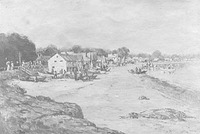 Fisherman's Beach, Swampscott, Masssachusetts prior to 1896 Blaney Beach, also known as Fisherman's Beach, was the center of the fishing industry in Swampscott. In 1896, the town built the Fish House to "replace the numerous individual fish houses." In 1897, the Report of the Park Commissioners stated that, "We have aimed at two things: a convenient and sanitary quarters and an architecturally attractive sturcture becoming of a high class pleasure resort." The fish house remains operational and is the only known municipal fish house still in use in the United States.--from Images of America : Swampscott, Turino and Mathias, 1996
Fisherman's Beach, Swampscott, Masssachusetts prior to 1896 Blaney Beach, also known as Fisherman's Beach, was the center of the fishing industry in Swampscott. In 1896, the town built the Fish House to "replace the numerous individual fish houses." In 1897, the Report of the Park Commissioners stated that, "We have aimed at two things: a convenient and sanitary quarters and an architecturally attractive sturcture becoming of a high class pleasure resort." The fish house remains operational and is the only known municipal fish house still in use in the United States.--from Images of America : Swampscott, Turino and Mathias, 1996 -
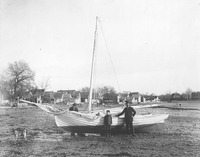 Lapstrake dory on beach Photo of a lapstrake dory on the beach in Swampscott. Included in the picture are Benjamin Martin and his son with an unidentified man.
Lapstrake dory on beach Photo of a lapstrake dory on the beach in Swampscott. Included in the picture are Benjamin Martin and his son with an unidentified man. -
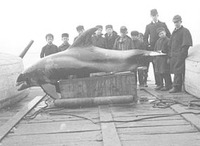 Porpoise at Blaney Beach Photo shows a large porpoise being taken ashore on the beach, with several onlookers.
Porpoise at Blaney Beach Photo shows a large porpoise being taken ashore on the beach, with several onlookers. -
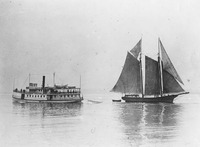 Boats in Swampscott Harbor Photo shows what appears to be a steamboat and a schooner in Swampscott Harbor.
Boats in Swampscott Harbor Photo shows what appears to be a steamboat and a schooner in Swampscott Harbor. -
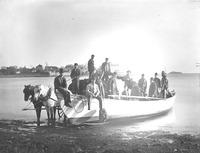 Crew of the schooner Jeannie P. Phillips Photo show the crew of the schooner Jeannie B. Phillips as the boat is landing ashore. There is a horse drawn cart beside the boat, and Lincoln House Point is in the background.
Crew of the schooner Jeannie P. Phillips Photo show the crew of the schooner Jeannie B. Phillips as the boat is landing ashore. There is a horse drawn cart beside the boat, and Lincoln House Point is in the background. -
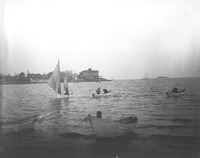 Swampscott Harbor This photo, by Stuart P. Ellis, shows fishermen working off Fisherman's Beach in sail powered dories in 1895. In the distance you can see the Lincoln House Hotel.--Kenneth Turino in Images of America: Swampscott.
Swampscott Harbor This photo, by Stuart P. Ellis, shows fishermen working off Fisherman's Beach in sail powered dories in 1895. In the distance you can see the Lincoln House Hotel.--Kenneth Turino in Images of America: Swampscott. -
 Fisherman's Beach, Swampscott, Mass. Panoramic photo shows the beach with rowboats and dories lined up along on the shore. In the foreground is a horse and buggy and several figures appear on the beach. Lincoln House Point appears in the background.
Fisherman's Beach, Swampscott, Mass. Panoramic photo shows the beach with rowboats and dories lined up along on the shore. In the foreground is a horse and buggy and several figures appear on the beach. Lincoln House Point appears in the background. -
 King's Beach Photo is taken from the water and shows the beach with fish houses and dories on the shore
King's Beach Photo is taken from the water and shows the beach with fish houses and dories on the shore -
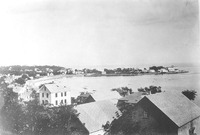 Lincoln House Point Photograph of Lincoln House Point, taken from Greenwood Avenue, showing the Lincoln House in the background and breaking surf in the foreground
Lincoln House Point Photograph of Lincoln House Point, taken from Greenwood Avenue, showing the Lincoln House in the background and breaking surf in the foreground -
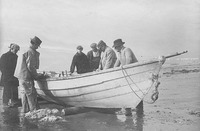 Fishermen on Blaney Beach 1910 Photo of seven fishermen on Blaney Beach in Swampscott
Fishermen on Blaney Beach 1910 Photo of seven fishermen on Blaney Beach in Swampscott -
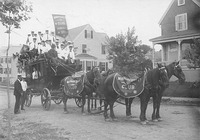 Fiftieth anniversary of Swampscott: Winnipesnett Club of Swampscott members riding on stage coach Members of the Winnipesnett Club of Swampscott ride on a stage coach in the town's 50th anniversary parade
Fiftieth anniversary of Swampscott: Winnipesnett Club of Swampscott members riding on stage coach Members of the Winnipesnett Club of Swampscott ride on a stage coach in the town's 50th anniversary parade -
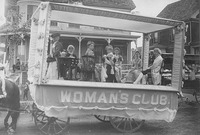 Fiftieth anniversary of Swampscott: Women's Club parade float (close-up) Side view of the Women's Club parade float "that featured a Colonial tableau on a horse-drawn cart."--from Images of America : Swampscott, Turino and Mathias, 1996
Fiftieth anniversary of Swampscott: Women's Club parade float (close-up) Side view of the Women's Club parade float "that featured a Colonial tableau on a horse-drawn cart."--from Images of America : Swampscott, Turino and Mathias, 1996 -
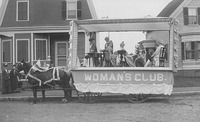 Fiftieth anniversary of Swampscott: Women's Club parade float Side view of the Women's Club parade float "that featured a Colonial tableau on a horse-drawn cart."--from Images of America : Swampscott, Turino and Mathias, 1996
Fiftieth anniversary of Swampscott: Women's Club parade float Side view of the Women's Club parade float "that featured a Colonial tableau on a horse-drawn cart."--from Images of America : Swampscott, Turino and Mathias, 1996 -
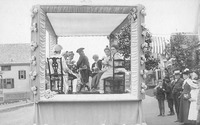 Fiftieth anniversary of Swampscott: Women's Club parade float (close-up) Side view of the Women's Club parade float "that featured a Colonial tableau on a horse-drawn cart."--from Images of America : Swampscott, Turino and Mathias, 1996
Fiftieth anniversary of Swampscott: Women's Club parade float (close-up) Side view of the Women's Club parade float "that featured a Colonial tableau on a horse-drawn cart."--from Images of America : Swampscott, Turino and Mathias, 1996 -
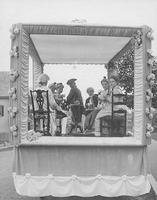 Fiftieth anniversary of Swampscott: Women's Club parade float Side view of the Women's Club parade float "that featured a Colonial tableau on a horse-drawn cart."--from Images of America : Swampscott, Turino and Mathias, 1996
Fiftieth anniversary of Swampscott: Women's Club parade float Side view of the Women's Club parade float "that featured a Colonial tableau on a horse-drawn cart."--from Images of America : Swampscott, Turino and Mathias, 1996 -
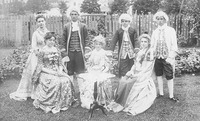 Fiftieth anniversary of Swampscott: garden scene Swampscott's 50th anniversary celebration "was met with much jubiliation on July 21, 1902. There was a sunrise firing of guns and ringing of bells, a parade at mid-day , and concerts and fireworks in the evening."--from Images of America : Swampscott, Turino and Mathias, 1996
Fiftieth anniversary of Swampscott: garden scene Swampscott's 50th anniversary celebration "was met with much jubiliation on July 21, 1902. There was a sunrise firing of guns and ringing of bells, a parade at mid-day , and concerts and fireworks in the evening."--from Images of America : Swampscott, Turino and Mathias, 1996 -
 Boy passes area destroyed by the Great Salem Fire The Great Salem Fire started at 1:37 PM on June 25, 1914 at the Korn Leather Factory located at 57 Boston Street. Fire departments from the following cities and towns responded to the alarms: Peabody, Lynn, Beverly, Swampscott, Marblehead, Boston, Chelsea, Wakefield, Danvers, Reading, Stoneham, Newburyport, Revere, Lawrence, Malden, Gloucester, Manchester, Medford, Hingham, Somerville, Winchester. In 1914, Salem's population was approximately, 48,000. The city covered 5100 acres and had 5826 buildings with a total valuation of $37,250,000. By the time it was through, "the conflagration [had] burned 253 acres, 1,376 buildings, the territory covered being 1 1/2 miles long by 1/2 mile wide the entire loss probably being much in excess of $15,000,000.00 the insurance loss paid $11,744,000.00, people homeless almost 20,000 and out of work, about 10,000." In the aftermath of the fire, Salem created a rebuilding commission charged with developing new building code and city planning regulations.
Boy passes area destroyed by the Great Salem Fire The Great Salem Fire started at 1:37 PM on June 25, 1914 at the Korn Leather Factory located at 57 Boston Street. Fire departments from the following cities and towns responded to the alarms: Peabody, Lynn, Beverly, Swampscott, Marblehead, Boston, Chelsea, Wakefield, Danvers, Reading, Stoneham, Newburyport, Revere, Lawrence, Malden, Gloucester, Manchester, Medford, Hingham, Somerville, Winchester. In 1914, Salem's population was approximately, 48,000. The city covered 5100 acres and had 5826 buildings with a total valuation of $37,250,000. By the time it was through, "the conflagration [had] burned 253 acres, 1,376 buildings, the territory covered being 1 1/2 miles long by 1/2 mile wide the entire loss probably being much in excess of $15,000,000.00 the insurance loss paid $11,744,000.00, people homeless almost 20,000 and out of work, about 10,000." In the aftermath of the fire, Salem created a rebuilding commission charged with developing new building code and city planning regulations. -
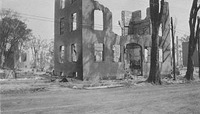 Building destroyed by the Great Salem Fire The Great Salem Fire started at 1:37 PM on June 25, 1914 at the Korn Leather Factory located at 57 Boston Street. Fire departments from the following cities and towns responded to the alarms: Peabody, Lynn, Beverly, Swampscott, Marblehead, Boston, Chelsea, Wakefield, Danvers, Reading, Stoneham, Newburyport, Revere, Lawrence, Malden, Gloucester, Manchester, Medford, Hingham, Somerville, Winchester. In 1914, Salem's population was approximately, 48,000. The city covered 5100 acres and had 5826 buildings with a total valuation of $37,250,000. By the time it was through, "the conflagration [had] burned 253 acres, 1,376 buildings, the territory covered being 1 1/2 miles long by 1/2 mile wide the entire loss probably being much in excess of $15,000,000.00 the insurance loss paid $11,744,000.00, people homeless almost 20,000 and out of work, about 10,000." In the aftermath of the fire, Salem created a rebuilding commission charged with developing new building code and city planning regulations.
Building destroyed by the Great Salem Fire The Great Salem Fire started at 1:37 PM on June 25, 1914 at the Korn Leather Factory located at 57 Boston Street. Fire departments from the following cities and towns responded to the alarms: Peabody, Lynn, Beverly, Swampscott, Marblehead, Boston, Chelsea, Wakefield, Danvers, Reading, Stoneham, Newburyport, Revere, Lawrence, Malden, Gloucester, Manchester, Medford, Hingham, Somerville, Winchester. In 1914, Salem's population was approximately, 48,000. The city covered 5100 acres and had 5826 buildings with a total valuation of $37,250,000. By the time it was through, "the conflagration [had] burned 253 acres, 1,376 buildings, the territory covered being 1 1/2 miles long by 1/2 mile wide the entire loss probably being much in excess of $15,000,000.00 the insurance loss paid $11,744,000.00, people homeless almost 20,000 and out of work, about 10,000." In the aftermath of the fire, Salem created a rebuilding commission charged with developing new building code and city planning regulations. -
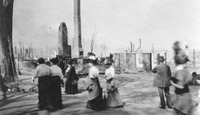 Citizens view wreckage from the Great Salem Fire The Great Salem Fire started at 1:37 PM on June 25, 1914 at the Korn Leather Factory located at 57 Boston Street. Fire departments from the following cities and towns responded to the alarms: Peabody, Lynn, Beverly, Swampscott, Marblehead, Boston, Chelsea, Wakefield, Danvers, Reading, Stoneham, Newburyport, Revere, Lawrence, Malden, Gloucester, Manchester, Medford, Hingham, Somerville, Winchester. In 1914, Salem's population was approximately, 48,000. The city covered 5100 acres and had 5826 buildings with a total valuation of $37,250,000. By the time it was through, "the conflagration [had] burned 253 acres, 1,376 buildings, the territory covered being 1 1/2 miles long by 1/2 mile wide the entire loss probably being much in excess of $15,000,000.00 the insurance loss paid $11,744,000.00, people homeless almost 20,000 and out of work, about 10,000." In the aftermath of the fire, Salem created a rebuilding commission charged with developing new building code and city planning regulations.
Citizens view wreckage from the Great Salem Fire The Great Salem Fire started at 1:37 PM on June 25, 1914 at the Korn Leather Factory located at 57 Boston Street. Fire departments from the following cities and towns responded to the alarms: Peabody, Lynn, Beverly, Swampscott, Marblehead, Boston, Chelsea, Wakefield, Danvers, Reading, Stoneham, Newburyport, Revere, Lawrence, Malden, Gloucester, Manchester, Medford, Hingham, Somerville, Winchester. In 1914, Salem's population was approximately, 48,000. The city covered 5100 acres and had 5826 buildings with a total valuation of $37,250,000. By the time it was through, "the conflagration [had] burned 253 acres, 1,376 buildings, the territory covered being 1 1/2 miles long by 1/2 mile wide the entire loss probably being much in excess of $15,000,000.00 the insurance loss paid $11,744,000.00, people homeless almost 20,000 and out of work, about 10,000." In the aftermath of the fire, Salem created a rebuilding commission charged with developing new building code and city planning regulations. -
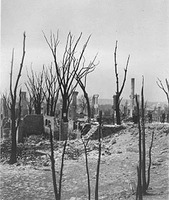 Charred landscape created by the Great Salem Fire The Great Salem Fire started at 1:37 PM on June 25, 1914 at the Korn Leather Factory located at 57 Boston Street. Fire departments from the following cities and towns responded to the alarms: Peabody, Lynn, Beverly, Swampscott, Marblehead, Boston, Chelsea, Wakefield, Danvers, Reading, Stoneham, Newburyport, Revere, Lawrence, Malden, Gloucester, Manchester, Medford, Hingham, Somerville, Winchester. In 1914, Salem's population was approximately, 48,000. The city covered 5100 acres and had 5826 buildings with a total valuation of $37,250,000. By the time it was through, "the conflagration [had] burned 253 acres, 1,376 buildings, the territory covered being 1 1/2 miles long by 1/2 mile wide the entire loss probably being much in excess of $15,000,000.00 the insurance loss paid $11,744,000.00, people homeless almost 20,000 and out of work, about 10,000." In the aftermath of the fire, Salem created a rebuilding commission charged with developing new building code and city planning regulations.
Charred landscape created by the Great Salem Fire The Great Salem Fire started at 1:37 PM on June 25, 1914 at the Korn Leather Factory located at 57 Boston Street. Fire departments from the following cities and towns responded to the alarms: Peabody, Lynn, Beverly, Swampscott, Marblehead, Boston, Chelsea, Wakefield, Danvers, Reading, Stoneham, Newburyport, Revere, Lawrence, Malden, Gloucester, Manchester, Medford, Hingham, Somerville, Winchester. In 1914, Salem's population was approximately, 48,000. The city covered 5100 acres and had 5826 buildings with a total valuation of $37,250,000. By the time it was through, "the conflagration [had] burned 253 acres, 1,376 buildings, the territory covered being 1 1/2 miles long by 1/2 mile wide the entire loss probably being much in excess of $15,000,000.00 the insurance loss paid $11,744,000.00, people homeless almost 20,000 and out of work, about 10,000." In the aftermath of the fire, Salem created a rebuilding commission charged with developing new building code and city planning regulations. -
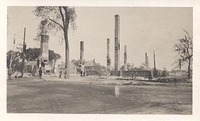 Destruction from the Great Salem Fire The Great Salem Fire started at 1:37 PM on June 25, 1914 at the Korn Leather Factory located at 57 Boston Street. Fire departments from the following cities and towns responded to the alarms: Peabody, Lynn, Beverly, Swampscott, Marblehead, Boston, Chelsea, Wakefield, Danvers, Reading, Stoneham, Newburyport, Revere, Lawrence, Malden, Gloucester, Manchester, Medford, Hingham, Somerville, Winchester. In 1914, Salem's population was approximately, 48,000. The city covered 5100 acres and had 5826 buildings with a total valuation of $37,250,000. By the time it was through, "the conflagration [had] burned 253 acres, 1,376 buildings, the territory covered being 1 1/2 miles long by 1/2 mile wide the entire loss probably being much in excess of $15,000,000.00 the insurance loss paid $11,744,000.00, people homeless almost 20,000 and out of work, about 10,000." In the aftermath of the fire, Salem created a rebuilding commission charged with developing new building code and city planning regulations.
Destruction from the Great Salem Fire The Great Salem Fire started at 1:37 PM on June 25, 1914 at the Korn Leather Factory located at 57 Boston Street. Fire departments from the following cities and towns responded to the alarms: Peabody, Lynn, Beverly, Swampscott, Marblehead, Boston, Chelsea, Wakefield, Danvers, Reading, Stoneham, Newburyport, Revere, Lawrence, Malden, Gloucester, Manchester, Medford, Hingham, Somerville, Winchester. In 1914, Salem's population was approximately, 48,000. The city covered 5100 acres and had 5826 buildings with a total valuation of $37,250,000. By the time it was through, "the conflagration [had] burned 253 acres, 1,376 buildings, the territory covered being 1 1/2 miles long by 1/2 mile wide the entire loss probably being much in excess of $15,000,000.00 the insurance loss paid $11,744,000.00, people homeless almost 20,000 and out of work, about 10,000." In the aftermath of the fire, Salem created a rebuilding commission charged with developing new building code and city planning regulations. -
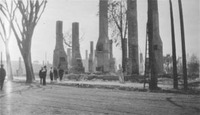 Citizens view destruction from the Great Salem Fire The Great Salem Fire started at 1:37 PM on June 25, 1914 at the Korn Leather Factory located at 57 Boston Street. Fire departments from the following cities and towns responded to the alarms: Peabody, Lynn, Beverly, Swampscott, Marblehead, Boston, Chelsea, Wakefield, Danvers, Reading, Stoneham, Newburyport, Revere, Lawrence, Malden, Gloucester, Manchester, Medford, Hingham, Somerville, Winchester. In 1914, Salem's population was approximately, 48,000. The city covered 5100 acres and had 5826 buildings with a total valuation of $37,250,000. By the time it was through, "the conflagration [had] burned 253 acres, 1,376 buildings, the territory covered being 1 1/2 miles long by 1/2 mile wide the entire loss probably being much in excess of $15,000,000.00 the insurance loss paid $11,744,000.00, people homeless almost 20,000 and out of work, about 10,000." In the aftermath of the fire, Salem created a rebuilding commission charged with developing new building code and city planning regulations.
Citizens view destruction from the Great Salem Fire The Great Salem Fire started at 1:37 PM on June 25, 1914 at the Korn Leather Factory located at 57 Boston Street. Fire departments from the following cities and towns responded to the alarms: Peabody, Lynn, Beverly, Swampscott, Marblehead, Boston, Chelsea, Wakefield, Danvers, Reading, Stoneham, Newburyport, Revere, Lawrence, Malden, Gloucester, Manchester, Medford, Hingham, Somerville, Winchester. In 1914, Salem's population was approximately, 48,000. The city covered 5100 acres and had 5826 buildings with a total valuation of $37,250,000. By the time it was through, "the conflagration [had] burned 253 acres, 1,376 buildings, the territory covered being 1 1/2 miles long by 1/2 mile wide the entire loss probably being much in excess of $15,000,000.00 the insurance loss paid $11,744,000.00, people homeless almost 20,000 and out of work, about 10,000." In the aftermath of the fire, Salem created a rebuilding commission charged with developing new building code and city planning regulations. -
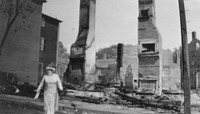 Great Salem Fire : chimneys of destroyed building The Great Salem Fire started at 1:37 PM on June 25, 1914 at the Korn Leather Factory located at 57 Boston Street. Fire departments from the following cities and towns responded to the alarms: Peabody, Lynn, Beverly, Swampscott, Marblehead, Boston, Chelsea, Wakefield, Danvers, Reading, Stoneham, Newburyport, Revere, Lawrence, Malden, Gloucester, Manchester, Medford, Hingham, Somerville, Winchester. In 1914, Salem's population was approximately, 48,000. The city covered 5100 acres and had 5826 buildings with a total valuation of $37,250,000. By the time it was through, "the conflagration [had] burned 253 acres, 1,376 buildings, the territory covered being 1 1/2 miles long by 1/2 mile wide the entire loss probably being much in excess of $15,000,000.00 the insurance loss paid $11,744,000.00, people homeless almost 20,000 and out of work, about 10,000." In the aftermath of the fire, Salem created a rebuilding commission charged with developing new building code and city planning regulations.
Great Salem Fire : chimneys of destroyed building The Great Salem Fire started at 1:37 PM on June 25, 1914 at the Korn Leather Factory located at 57 Boston Street. Fire departments from the following cities and towns responded to the alarms: Peabody, Lynn, Beverly, Swampscott, Marblehead, Boston, Chelsea, Wakefield, Danvers, Reading, Stoneham, Newburyport, Revere, Lawrence, Malden, Gloucester, Manchester, Medford, Hingham, Somerville, Winchester. In 1914, Salem's population was approximately, 48,000. The city covered 5100 acres and had 5826 buildings with a total valuation of $37,250,000. By the time it was through, "the conflagration [had] burned 253 acres, 1,376 buildings, the territory covered being 1 1/2 miles long by 1/2 mile wide the entire loss probably being much in excess of $15,000,000.00 the insurance loss paid $11,744,000.00, people homeless almost 20,000 and out of work, about 10,000." In the aftermath of the fire, Salem created a rebuilding commission charged with developing new building code and city planning regulations. -
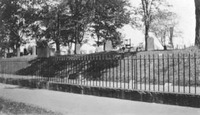 View of a cemetery after the Great Salem Fire The Great Salem Fire started at 1:37 PM on June 25, 1914 at the Korn Leather Factory located at 57 Boston Street. Fire departments from the following cities and towns responded to the alarms: Peabody, Lynn, Beverly, Swampscott, Marblehead, Boston, Chelsea, Wakefield, Danvers, Reading, Stoneham, Newburyport, Revere, Lawrence, Malden, Gloucester, Manchester, Medford, Hingham, Somerville, Winchester. In 1914, Salem's population was approximately, 48,000. The city covered 5100 acres and had 5826 buildings with a total valuation of $37,250,000. By the time it was through, "the conflagration [had] burned 253 acres, 1,376 buildings, the territory covered being 1 1/2 miles long by 1/2 mile wide the entire loss probably being much in excess of $15,000,000.00 the insurance loss paid $11,744,000.00, people homeless almost 20,000 and out of work, about 10,000." In the aftermath of the fire, Salem created a rebuilding commission charged with developing new building code and city planning regulations.
View of a cemetery after the Great Salem Fire The Great Salem Fire started at 1:37 PM on June 25, 1914 at the Korn Leather Factory located at 57 Boston Street. Fire departments from the following cities and towns responded to the alarms: Peabody, Lynn, Beverly, Swampscott, Marblehead, Boston, Chelsea, Wakefield, Danvers, Reading, Stoneham, Newburyport, Revere, Lawrence, Malden, Gloucester, Manchester, Medford, Hingham, Somerville, Winchester. In 1914, Salem's population was approximately, 48,000. The city covered 5100 acres and had 5826 buildings with a total valuation of $37,250,000. By the time it was through, "the conflagration [had] burned 253 acres, 1,376 buildings, the territory covered being 1 1/2 miles long by 1/2 mile wide the entire loss probably being much in excess of $15,000,000.00 the insurance loss paid $11,744,000.00, people homeless almost 20,000 and out of work, about 10,000." In the aftermath of the fire, Salem created a rebuilding commission charged with developing new building code and city planning regulations. -
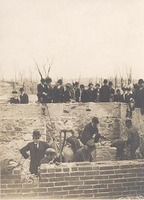 Great Salem Fire : surveying damage The Great Salem Fire started at 1:37 PM on June 25, 1914 at the Korn Leather Factory located at 57 Boston Street. Fire departments from the following cities and towns responded to the alarms: Peabody, Lynn, Beverly, Swampscott, Marblehead, Boston, Chelsea, Wakefield, Danvers, Reading, Stoneham, Newburyport, Revere, Lawrence, Malden, Gloucester, Manchester, Medford, Hingham, Somerville, Winchester. In 1914, Salem's population was approximately, 48,000. The city covered 5100 acres and had 5826 buildings with a total valuation of $37,250,000. By the time it was through, "the conflagration [had] burned 253 acres, 1,376 buildings, the territory covered being 1 1/2 miles long by 1/2 mile wide the entire loss probably being much in excess of $15,000,000.00 the insurance loss paid $11,744,000.00, people homeless almost 20,000 and out of work, about 10,000." In the aftermath of the fire, Salem created a rebuilding commission charged with developing new building code and city planning regulations.
Great Salem Fire : surveying damage The Great Salem Fire started at 1:37 PM on June 25, 1914 at the Korn Leather Factory located at 57 Boston Street. Fire departments from the following cities and towns responded to the alarms: Peabody, Lynn, Beverly, Swampscott, Marblehead, Boston, Chelsea, Wakefield, Danvers, Reading, Stoneham, Newburyport, Revere, Lawrence, Malden, Gloucester, Manchester, Medford, Hingham, Somerville, Winchester. In 1914, Salem's population was approximately, 48,000. The city covered 5100 acres and had 5826 buildings with a total valuation of $37,250,000. By the time it was through, "the conflagration [had] burned 253 acres, 1,376 buildings, the territory covered being 1 1/2 miles long by 1/2 mile wide the entire loss probably being much in excess of $15,000,000.00 the insurance loss paid $11,744,000.00, people homeless almost 20,000 and out of work, about 10,000." In the aftermath of the fire, Salem created a rebuilding commission charged with developing new building code and city planning regulations. -
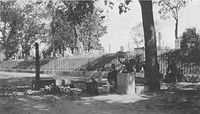 Men outside of a cemetery after the Great Salem Fire The Great Salem Fire started at 1:37 PM on June 25, 1914 at the Korn Leather Factory located at 57 Boston Street. Fire departments from the following cities and towns responded to the alarms: Peabody, Lynn, Beverly, Swampscott, Marblehead, Boston, Chelsea, Wakefield, Danvers, Reading, Stoneham, Newburyport, Revere, Lawrence, Malden, Gloucester, Manchester, Medford, Hingham, Somerville, Winchester. In 1914, Salem's population was approximately, 48,000. The city covered 5100 acres and had 5826 buildings with a total valuation of $37,250,000. By the time it was through, "the conflagration [had] burned 253 acres, 1,376 buildings, the territory covered being 1 1/2 miles long by 1/2 mile wide the entire loss probably being much in excess of $15,000,000.00 the insurance loss paid $11,744,000.00, people homeless almost 20,000 and out of work, about 10,000." In the aftermath of the fire, Salem created a rebuilding commission charged with developing new building code and city planning regulations.
Men outside of a cemetery after the Great Salem Fire The Great Salem Fire started at 1:37 PM on June 25, 1914 at the Korn Leather Factory located at 57 Boston Street. Fire departments from the following cities and towns responded to the alarms: Peabody, Lynn, Beverly, Swampscott, Marblehead, Boston, Chelsea, Wakefield, Danvers, Reading, Stoneham, Newburyport, Revere, Lawrence, Malden, Gloucester, Manchester, Medford, Hingham, Somerville, Winchester. In 1914, Salem's population was approximately, 48,000. The city covered 5100 acres and had 5826 buildings with a total valuation of $37,250,000. By the time it was through, "the conflagration [had] burned 253 acres, 1,376 buildings, the territory covered being 1 1/2 miles long by 1/2 mile wide the entire loss probably being much in excess of $15,000,000.00 the insurance loss paid $11,744,000.00, people homeless almost 20,000 and out of work, about 10,000." In the aftermath of the fire, Salem created a rebuilding commission charged with developing new building code and city planning regulations. -
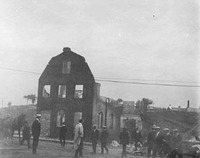 Citizens inspect a building destoyed in the Great Salem Fire The Great Salem Fire started at 1:37 PM on June 25, 1914 at the Korn Leather Factory located at 57 Boston Street. Fire departments from the following cities and towns responded to the alarms: Peabody, Lynn, Beverly, Swampscott, Marblehead, Boston, Chelsea, Wakefield, Danvers, Reading, Stoneham, Newburyport, Revere, Lawrence, Malden, Gloucester, Manchester, Medford, Hingham, Somerville, Winchester. In 1914, Salem's population was approximately, 48,000. The city covered 5100 acres and had 5826 buildings with a total valuation of $37,250,000. By the time it was through, "the conflagration [had] burned 253 acres, 1,376 buildings, the territory covered being 1 1/2 miles long by 1/2 mile wide the entire loss probably being much in excess of $15,000,000.00 the insurance loss paid $11,744,000.00, people homeless almost 20,000 and out of work, about 10,000." In the aftermath of the fire, Salem created a rebuilding commission charged with developing new building code and city planning regulations.
Citizens inspect a building destoyed in the Great Salem Fire The Great Salem Fire started at 1:37 PM on June 25, 1914 at the Korn Leather Factory located at 57 Boston Street. Fire departments from the following cities and towns responded to the alarms: Peabody, Lynn, Beverly, Swampscott, Marblehead, Boston, Chelsea, Wakefield, Danvers, Reading, Stoneham, Newburyport, Revere, Lawrence, Malden, Gloucester, Manchester, Medford, Hingham, Somerville, Winchester. In 1914, Salem's population was approximately, 48,000. The city covered 5100 acres and had 5826 buildings with a total valuation of $37,250,000. By the time it was through, "the conflagration [had] burned 253 acres, 1,376 buildings, the territory covered being 1 1/2 miles long by 1/2 mile wide the entire loss probably being much in excess of $15,000,000.00 the insurance loss paid $11,744,000.00, people homeless almost 20,000 and out of work, about 10,000." In the aftermath of the fire, Salem created a rebuilding commission charged with developing new building code and city planning regulations. -
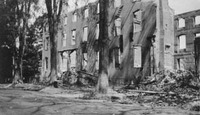 Remains of a building destroyed in the Great Salem Fire The Great Salem Fire started at 1:37 PM on June 25, 1914 at the Korn Leather Factory located at 57 Boston Street. Fire departments from the following cities and towns responded to the alarms: Peabody, Lynn, Beverly, Swampscott, Marblehead, Boston, Chelsea, Wakefield, Danvers, Reading, Stoneham, Newburyport, Revere, Lawrence, Malden, Gloucester, Manchester, Medford, Hingham, Somerville, Winchester. In 1914, Salem's population was approximately, 48,000. The city covered 5100 acres and had 5826 buildings with a total valuation of $37,250,000. By the time it was through, "the conflagration [had] burned 253 acres, 1,376 buildings, the territory covered being 1 1/2 miles long by 1/2 mile wide the entire loss probably being much in excess of $15,000,000.00 the insurance loss paid $11,744,000.00, people homeless almost 20,000 and out of work, about 10,000." In the aftermath of the fire, Salem created a rebuilding commission charged with developing new building code and city planning regulations.
Remains of a building destroyed in the Great Salem Fire The Great Salem Fire started at 1:37 PM on June 25, 1914 at the Korn Leather Factory located at 57 Boston Street. Fire departments from the following cities and towns responded to the alarms: Peabody, Lynn, Beverly, Swampscott, Marblehead, Boston, Chelsea, Wakefield, Danvers, Reading, Stoneham, Newburyport, Revere, Lawrence, Malden, Gloucester, Manchester, Medford, Hingham, Somerville, Winchester. In 1914, Salem's population was approximately, 48,000. The city covered 5100 acres and had 5826 buildings with a total valuation of $37,250,000. By the time it was through, "the conflagration [had] burned 253 acres, 1,376 buildings, the territory covered being 1 1/2 miles long by 1/2 mile wide the entire loss probably being much in excess of $15,000,000.00 the insurance loss paid $11,744,000.00, people homeless almost 20,000 and out of work, about 10,000." In the aftermath of the fire, Salem created a rebuilding commission charged with developing new building code and city planning regulations. -
 Bass Point House : 6 The Bass Point House was one of several resort hotels located in Nahant, Massachusetts, which became a popular vacation destination from the 1820's on. This photo shows a side view of the hotel, with a two story porch with a sign in large letters saying dancing above the porch. The wharf is also visible on the left, with the beach in the foreground.
Bass Point House : 6 The Bass Point House was one of several resort hotels located in Nahant, Massachusetts, which became a popular vacation destination from the 1820's on. This photo shows a side view of the hotel, with a two story porch with a sign in large letters saying dancing above the porch. The wharf is also visible on the left, with the beach in the foreground. -
 Bass Point House : 5 The Bass Point House was one of several resort hotels located in Nahant, Massachusetts, which became a popular vacation destination from the 1820's on. This photo, which is almost identical to photo #4, shows a side view of the hotel, with a two story porch bearing a sign Bass Point House, as well as a smaller sign saying auction, on the top. There is also a large sign painted on the body of the hotel with the words Bass Point House, Jas. I. Purcell, Prop.
Bass Point House : 5 The Bass Point House was one of several resort hotels located in Nahant, Massachusetts, which became a popular vacation destination from the 1820's on. This photo, which is almost identical to photo #4, shows a side view of the hotel, with a two story porch bearing a sign Bass Point House, as well as a smaller sign saying auction, on the top. There is also a large sign painted on the body of the hotel with the words Bass Point House, Jas. I. Purcell, Prop. -
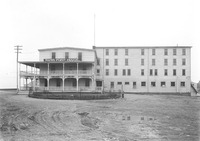 Bass Point House : 4 The Bass Point House was one of several resort hotels located in Nahant, Massachusetts, which became a popular vacation destination from the 1820's on. This photo shows a side view of the hotel, with a two story porch bearing a sign Bass Point House on the top.
Bass Point House : 4 The Bass Point House was one of several resort hotels located in Nahant, Massachusetts, which became a popular vacation destination from the 1820's on. This photo shows a side view of the hotel, with a two story porch bearing a sign Bass Point House on the top. -
 Bass Point House : 3 The Bass Point House was one of several resort hotels located in Nahant, Massachusetts, which became a popular vacation destination from the 1820's on. This photo is taken from the road leading up to the hotel, and shows the entire hotel on the right, along with the beach. Another building, which could be an amusement arcade, is located on the left.
Bass Point House : 3 The Bass Point House was one of several resort hotels located in Nahant, Massachusetts, which became a popular vacation destination from the 1820's on. This photo is taken from the road leading up to the hotel, and shows the entire hotel on the right, along with the beach. Another building, which could be an amusement arcade, is located on the left. -
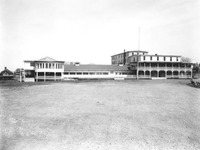 Bass Point House : 2 The Bass Point House was one of several resort hotels located in the Bass Point section of Nahant, Massachusetts, which became a popular vacation destination from the 1820's on. This photo is a panoramic picture showing the road leading up to the hotel.
Bass Point House : 2 The Bass Point House was one of several resort hotels located in the Bass Point section of Nahant, Massachusetts, which became a popular vacation destination from the 1820's on. This photo is a panoramic picture showing the road leading up to the hotel. -
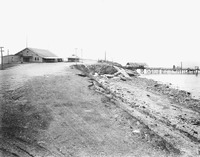 Bass Point House : 1 The Bass Point House was one of several resort hotels located in Nahant, Massachusetts, which became a popular vacation destination from the 1820's on. This photo shows a wooden wharf on the right and the rear of the hotel to the left.
Bass Point House : 1 The Bass Point House was one of several resort hotels located in Nahant, Massachusetts, which became a popular vacation destination from the 1820's on. This photo shows a wooden wharf on the right and the rear of the hotel to the left. -
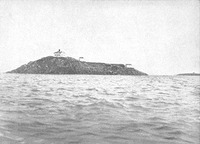 Egg Rock Light Egg Rock is a little less than a mile northeast of the town of Nahant. The three-acre island is about 80 feet high and can be seen from many locations north of Boston, from Winthrop to Marblehead. The first lighthouse was built on Egg Rock in 1856 with Congressional funding. The lighthouse was considered essential in guiding Swampscott's growing fishing fleet safely to port. "The lighthouse's fifth-order Fresnel lens produced a fixed white light, first exhibited on September 15, 1856. It was changed to red a year later in reaction to the wreck of the schooner Shark, whose captain had mistaken Egg Rock Light for Long Island Head Light in Boston Harbor." After a fire, "the lighthouse was rebuilt in 1897 with the addition of an oil house in 1904, and a new pier and boat house in 1906. During World War I, the light at Egg Rock was dimmed because of fears of enemy submarines in the area. By 1919, an automatic gas-operated beacon was placed in the tower, but in 1922, the light was discontinued. The government sold the buildings at auction for $160, requiring the new owner to remove the buildings from the island. During this move, a cable snapped and the house tumbled into the ocean. Today, Egg Rock is the home of the Henry Cabot Lodge wildlife sanctuary.--from New England Lighthouses : a virtual guide, viewed 03-17-2008.
Egg Rock Light Egg Rock is a little less than a mile northeast of the town of Nahant. The three-acre island is about 80 feet high and can be seen from many locations north of Boston, from Winthrop to Marblehead. The first lighthouse was built on Egg Rock in 1856 with Congressional funding. The lighthouse was considered essential in guiding Swampscott's growing fishing fleet safely to port. "The lighthouse's fifth-order Fresnel lens produced a fixed white light, first exhibited on September 15, 1856. It was changed to red a year later in reaction to the wreck of the schooner Shark, whose captain had mistaken Egg Rock Light for Long Island Head Light in Boston Harbor." After a fire, "the lighthouse was rebuilt in 1897 with the addition of an oil house in 1904, and a new pier and boat house in 1906. During World War I, the light at Egg Rock was dimmed because of fears of enemy submarines in the area. By 1919, an automatic gas-operated beacon was placed in the tower, but in 1922, the light was discontinued. The government sold the buildings at auction for $160, requiring the new owner to remove the buildings from the island. During this move, a cable snapped and the house tumbled into the ocean. Today, Egg Rock is the home of the Henry Cabot Lodge wildlife sanctuary.--from New England Lighthouses : a virtual guide, viewed 03-17-2008. -
 Nahant cottage Photo shows a large "cottage" in Nahant, Massachusetts on what is now the present site of the Nahant Country Club.
Nahant cottage Photo shows a large "cottage" in Nahant, Massachusetts on what is now the present site of the Nahant Country Club. -
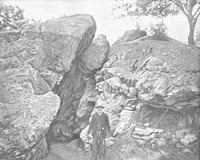 Dungeon Rock, Lynn Woods "Late in the summer of 1658, a sinister ship appeared in Lynn Harbor. The ship was painted black and flew no flag. Word spread quickly among the citizens of the small town of Lynn, Massachusetts: There were pirates in the harbor! A boat was lowered from the ship, a chest was loaded into the boat, and four oarsmen rowed it toward shore. The boat headed up the Saugus River and landed near the Saugus Iron Works. The next day, workers found a note attached to a door, asking to purchase a supply of shackles, hatchets, shovels, and other tools. The note promised that if the requested tools were manufactured and left at a secret location, then a supply of silver would be left in exchange. The tools were made and paid for as promised. The pirates made camp in a place now known as Pirate's Glen near the Saugus River. British soldiers stationed nearby heard about the pirates and set off to capture them. Three of the buccaneers were captured and hanged but the forth, Thomas Veal, escaped into the woods. It was believed that he took the stolen hoard with him as he headed deeper and deeper into the woods, finally arriving at a natural cave in what is now Lynn Woods. Veal lived in the cave for some time and became a member of the Lynn community. The story says he mended shoes for spending money and lived in relative peace with his neighbors. Suddenly, an earthquake rocked the Lynn area, causing a gigantic piece of the rock to tip forward and permanently seal the cave opening. Poor Veal was either trapped inside or crushed to death with his treasure, locked forever in Dungeon Rock. The remains of Thomas Veal and his treasure were left undisturbed for nearly two hundred years.
Dungeon Rock, Lynn Woods "Late in the summer of 1658, a sinister ship appeared in Lynn Harbor. The ship was painted black and flew no flag. Word spread quickly among the citizens of the small town of Lynn, Massachusetts: There were pirates in the harbor! A boat was lowered from the ship, a chest was loaded into the boat, and four oarsmen rowed it toward shore. The boat headed up the Saugus River and landed near the Saugus Iron Works. The next day, workers found a note attached to a door, asking to purchase a supply of shackles, hatchets, shovels, and other tools. The note promised that if the requested tools were manufactured and left at a secret location, then a supply of silver would be left in exchange. The tools were made and paid for as promised. The pirates made camp in a place now known as Pirate's Glen near the Saugus River. British soldiers stationed nearby heard about the pirates and set off to capture them. Three of the buccaneers were captured and hanged but the forth, Thomas Veal, escaped into the woods. It was believed that he took the stolen hoard with him as he headed deeper and deeper into the woods, finally arriving at a natural cave in what is now Lynn Woods. Veal lived in the cave for some time and became a member of the Lynn community. The story says he mended shoes for spending money and lived in relative peace with his neighbors. Suddenly, an earthquake rocked the Lynn area, causing a gigantic piece of the rock to tip forward and permanently seal the cave opening. Poor Veal was either trapped inside or crushed to death with his treasure, locked forever in Dungeon Rock. The remains of Thomas Veal and his treasure were left undisturbed for nearly two hundred years. -
 Breed's Pond, Lynn, Massachusetts Photo shows Breeds Pond in Lynn, Massachusetts, located off of Parkland Avenue at the edge of the Lynn Woods Reservation. The photo shows the pond on the left surrounded by woods.
Breed's Pond, Lynn, Massachusetts Photo shows Breeds Pond in Lynn, Massachusetts, located off of Parkland Avenue at the edge of the Lynn Woods Reservation. The photo shows the pond on the left surrounded by woods.
